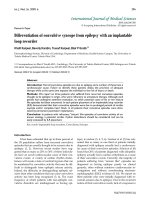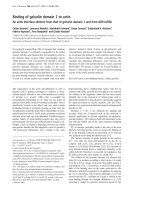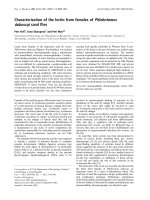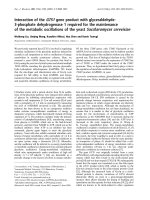Báo cáo y học: " Differentiation of convulsive syncope from epilepsy with an implantable loop recorder Khalil Kanjwal, Beverly Karabin, Yousuf Kanjwal, Blair P Grubb"
Bạn đang xem bản rút gọn của tài liệu. Xem và tải ngay bản đầy đủ của tài liệu tại đây (1.04 MB, 5 trang )
Int. J. Med. Sci. 2009, 6
296
I
I
n
n
t
t
e
e
r
r
n
n
a
a
t
t
i
i
o
o
n
n
a
a
l
l
J
J
o
o
u
u
r
r
n
n
a
a
l
l
o
o
f
f
M
M
e
e
d
d
i
i
c
c
a
a
l
l
S
S
c
c
i
i
e
e
n
n
c
c
e
e
s
s
2009; 6(6):296-300
© Ivyspring International Publisher. All rights reserved
Research Paper
Differentiation of convulsive syncope from epilepsy with an implantable
loop recorder
Khalil Kanjwal, Beverly Karabin, Yousuf Kanjwal, Blair P Grubb
Electrophysiology Section, Division of Cardiology, Department of Medicine, Health Science Campus, The University of
Toledo Medical Center, Toledo Ohio USA.
Correspondence to: Blair P Grubb M.D., Cardiology, The University of Toledo Medical Center, 3000 Arlington ave Toledo
OH 43614. ; Fax 41
9-383-3041; Phone 419-383-3697
Received: 2009.07.24; Accepted: 2009.09.11; Published: 2009.09.15
Abstract
Introduction: Not all convulsive episodes are due to epilepsy and a number of these have a
cardiovascular cause. Failure to identify these patients delays the provision of adequate
therapy while at the same time exposes the individual to the risk of injury or death.
Methods: We report on three patients who suffered from recurrent convulsive episodes,
thought to be epileptic in origin, who were refractory to antiseizure therapy. Although each
patient had undergone extensive evaluation, no other potential cause of his or her seizure
like episodes had been uncovered. In each patient placement of an implantable loop recorder
(ILR) demonstrated that their convulsive episodes were due to prolonged periods of cardiac
asystole and/or complete heart block. In all patients their convulsive episodes were elimi-
nated by permanent pacemaker implantation.
Conclusion: In patients with refractory “seizure’ like episodes of convulsive activity of un-
known etiology a potential cardiac rhythm disturbance should be considered and can be
easily evaluated by ILR placement.
Key words: Implantable loop recorders, Convulsions, Syncope.
Introduction
It has been estimated that up to three percent of
the US population suffers from recurrent convulsive
episodes that are usually thought to be seizures due to
epilepsy (1, 2). However recent studies have sug-
gested that as many as 20% to 30% of these individu-
als have an occult cardiovascular cause of their con-
vulsive events. A variety of cardiac rhythm distur-
bances will create a state of cerebral hypoxia that can
be manifested by convulsive activity that may be dif-
ficult to distinguish from epileptic seizure activity.
Indeed, the difficulty in distinguishing epileptic sei-
zures from other conditions that can cause convulsive
activity has been long recognized (3, 4). The exact
frequency at which patients with non-epileptic con-
vulsive disorders are misdiagnosed as having epi-
lepsy is unclear (3, 4, 5, 6). Gastaut et al (7) has esti-
mated that as many as one third of patients initially
diagnosed with epilepsy actually had a cardiovascu-
lar cause of their convulsive episodes. Schott et al (8)
found that 20% of patients diagnosed with idiopathic
epilepsy actually had a cardiac arrhythmia as a cause
of their convulsive events. Currently, the majority of
patients suffering from “seizure like” episodes are
diagnosed as having epilepsy purely on clinical
grounds, often without extensive cardiovascular in-
vestigations and without corroborating electroen-
cephalographic (EEG) evidence (9, 10). We report on
three patients who were initially diagnosed with re-
current seizures due to epilepsy. Due to the recurrent
nature of their convulsive events, lack of a response to
Int. J. Med. Sci. 2009, 6
297
anti-seizure medications, and normal cardiac evalua-
tions patients were referred to our center for further
evaluation. It was only following prolonged cardiac
rhythm monitoring with an implantable loop recorder
(ILR) that a cardiac rhythm abnormality was identi-
fied as the cause of their recurrent convulsive events.
Case 1
A 10 year-old young man who had suffered from
recurrent idiopathic “seizures” since he was one year
of age was referred for evaluation. During these epi-
sodes the patient would suddenly turn pale then
abruptly fall to the floor followed by convulsive ac-
tivity that would last anywhere from 30 seconds to
one minute. He would often be incontinent of urine
and have a postictal period of confusion and disori-
entation lasting from ten to twenty minutes, followed
by severe confusion and fatigue that would persist for
the remainder of the day. The patient would experi-
ence between five and seven major episodes each
year, as well as less severe episodes every one to two
months. The patient had undergone extensive neu-
rologic and cardiovascular evaluation at the several
major medical centers in the US, yet an etiology for
these events could not be found. The patients’ elec-
trocardiogram, echocardiogram, baseline and sleep
deprived electroencephalogram (EEG), and magnetic
resonance imaging (MRI) scan of the brain were all
normal (each having been repeated multiple times). A
head upright tilt table test was normal as was an ex-
ercise stress test. He was tried on multiple seizure
medications to no avail. External event recorders were
unable to capture an episode. An ILR (Medtronic Re-
veal XT) was inserted in the patient and one month
later, the patient experienced a witnessed “mild”
convulsive episode while sitting at the table. The
download of the ILR showed the patient had experi-
enced > 20 seconds of cardiac systole coincident with
the episode (Figure 1). Afterward he underwent dual
chamber pacemaker placement and over a ten-month
follow-up has had no further convulsive events.
Case 2
A 41-year-old woman was referred for evalua-
tion of recurrent convulsive episodes. At the age of 29
years, she began to experience episodes of sudden
loss of consciousness associated with convulsive ac-
tivity. Her husband described each episode as similar
in nature. She would experience a prodrome of ring-
ing in her ears followed by an abrupt loss of con-
sciousness. She would become pale “her eyes would
roll back” and she would collapse to the floor. She
would then experience convulsive activity that would
last between 10 seconds and 15 minutes. During epi-
sodes, she would experience urinary incontinence and
on two episodes had fecal incontinence. She also suf-
fered from multiple traumatic injuries to her face head
and arms during these episodes. She underwent an
extensive series of neurologic and cardiovascular
evaluations at several institutions over the years yet
no etiology for the events could be found. The elec-
trocardiogram, echocardiogram, EEG, and MRI of the
brain were normal. Head upright tilt table testing was
normal (on two occasions), as was an exercise toler-
ance test. A cardiac catheterization and cardiac elec-
trophysiology study were both normal. A sleep study
was also normal. Prolonged external cardiac event
monitoring was unable to capture an episode. Her
recurrent unpredictable episodes caused her to be-
come reclusive and homebound. After consultation at
our institution, she underwent ILR implantation
(Medtronic Reveal Dx). This demonstrated that her
witnessed convulsive events were associated with
prolonged episodes of cardiac asystole and complete
heart block (Figure 2). Since pacemaker implantation,
she has had no further convulsive episodes over a
17-month follow up period.
Case 3
A 51-year-old woman had a nine-year history of
recurrent convulsive episodes thought to be seizures.
Her episodes were intermittent, occurring without
any prodrome and were associated with convulsive
activity. Episodes were associated with urinary in-
continence and a post-ictal confusional state. The falls
associated with three episodes resulted in trauma to
the head, face and arms. She underwent an extensive
neurologic and cardiovascular evaluation at several
institutions, yet no etiology could be found. An elec-
trocardiogram, echocardiogram, EEG and MRI of the
brain were normal (each having been repeated multi-
ple times). Head upright tilt table testing was per-
formed on two separate occasions and were both
normal. An exercise tolerance test was normal. A car-
diac electrophysiology study normal, as was a sleep
study. External event monitors were unable to capture
an episode. She was tried on multiple anti-seizure
medications yet none of these altered the frequency or
severity of her events. After being seen at our institu-
tion, she underwent ILR placement (Medtronic Dx).
The ILR demonstrated that her witnessed convulsive
events were associated with periods of a cardiac
asystole lasting up to 40 seconds in duration. Follow-
ing implantation of a dual chamber pacemaker, her
convulsive episodes have disappeared and have not
recurred over a one-year follow up period.
Int. J. Med. Sci. 2009, 6
298
Discussion
Syncope, the transient loss of consciousness with
spontaneous recovery occurs as consequence of a pe-
riod of cerebral hypoxia. A number of conditions may
disturb cerebral oxygenation, ranging from cardiac
arrhythmias to periods of autonomic nervous system
decompensation resulting in systemic hypotension
and bradycardia. In some individuals, global cerebral
hypoxia may result not only in loss of consciousness
but in convulsive activity as well (6, 7, 8). These epi-
sodes of “convulsive syncope” may at times be diffi-
cult to distinguish from seizures resulting from epi-
lepsy. Indeed, some studies have reported that any-
where between 30 -42% of patients initially thought to
have epileptic seizures were later found to have con-
vulsive syncope due to cardiovascular cause (3, 4).
While a careful history and physical examination
combined with directed laboratory testing are often
effective in arriving at a diagnosis, in some patients
establishing a clear cause for recurrent convulsive
episodes may be difficult (5,6,7,8). Autonomically
mediated forms of reflex syncope (such as neurocar-
diogenic or vasovagal syncope) may produce sudden
episodes of profound hypotension and bradycardia
resulting in loss of consciousness and, on occasion,
convulsive activity (11-12). Linzer et al (6) reported
that upto 12% of blood donors with neurocardiogenic
syncope (NCS) displayed convulsive activity. We
previously reported on 15 patients with recurrent
seizure like episodes (thought to be due to epilepsy)
unresponsive to anti-epileptic agents that were found
to have convulsive NCS induced during head up tilt
table testing (13).
While useful, tilt table testing is unable to iden-
tify all patients with severe NCS. In these individuals,
ILR’s have proven extremely valuable in detecting
bradycardia and asystole due to NCS. By allowing for
automatic recording of events and prolonged moni-
toring (up to 3 years) these devices provide a much
higher diagnostic yield than traditional monitoring
techniques. Zaidi et al (14) found that close to 45% of
patients with atypical seizures had a cardiac related
cause of these episodes, and it was only because of
prolonged monitoring with an ILR that allowed this
identification to be made.
In each of the patients described, the history
alone did not suggest a cardiovascular cause for their
convulsive events. In addition, extensive neurologic
and cardiovascular evaluation failed to uncover the
cause as well. It was only through prolonged moni-
toring with an ILR that a diagnosis could be estab-
lished and adequate therapy pursued. In all three pa-
tients the presumed mechanism of the observed pe-
riods of asystole was neurocardiogenic in nature.
These findings would be consistent with the classifi-
cation of ILR monitored events proposed by Brignole
et al (15) where the “type 1” asystolic events described
here suggest that the episodes are probably due to
neurocardiogenic (or neurally-mediated) mecha-
nisms. Further information regarding mechanisms of
neurocargiogenic syncope can be found elsewhere
(16,17). In each patient pacemaker placement resulted
in dramatic improvement in their quality of life. While
it is possible that the asystolic periods observed in
these patients during ILR monitoring may have been
caused by an epileptic seizure, the complete disap-
pearance of their convulsive episodes after pacemaker
placement tends to argue against this explanation.
Conclusion
In patients, suffering from recurrent convulsive
episodes of unknown etiology prolonged cardiac
monitoring with an ILR may help identify those indi-
viduals with a potentially treatable cardiac arrhyth-
mic cause.
Conflict of Interest
The authors have declared that no conflict of in-
terest exists.
References
1. Hauser WA, Kurland LT. The epidemiology of epilepsy in
Rochester, Minnesota, 1935 through 1967. Epilepsia.
1975;16(1):1-66.
2. Hauser WA, Hesdorffer DC. Epilepsy, Frequency, causes and
consequences. New York: Demos. 1990:21-8
3. Smith D, Defalla BA, Chadwick DW. The misdiagnosis of epi-
lepsy and the management of epilepsy in a specialist clinic. Q J
Med 1999; 92:15–23.
4. Scheepers B, Clough P, Pickles C. The misdiagnosis of epilepsy:
findings of a population study. Seizure 1998; 5:403– 6.
5. Devinsky O. Psychogenic seizures and syncope. In: Feldman,
editor. Current Diagnosis in Neurology. St Louis: Mosby–Year
Book, 1994:1–6.
6. Linzer M, Varia I, Pontinen M, Divine GW, Grubb BP, Estes
NA. Medically unexplained syncope: relation to psychiatric
illness. Am J Med 1992; 92(1A):18S–25S.
7. Gastaut H, Fisher William M. Electroencephalographic study of
syncope: its differentiation from epilepsy. Lancet 1957; ii:
1018-25.
8. Schott GD, McLeod AA, Jewitt DE. Cardiac arrhythmias that
masquerade as epilepsy. BMJ 1977; 1:1454 –7
9. Shorvon S. Medical assessment and treatment of chronic epi-
lepsy. BMJ 1991; 302:363– 6.
10. Chadwick D. Epilepsy. J Neurol Neurosurg Psychiatry
1994;57:264– 77.
11. Kapoor WN. Evaluation and outcome of patients with syncope.
Medicine (Balt) 1990;69:160-75.
12. Day SC, Cook EF, Funkenstein H, Goldman L. Evaluation and
outcome of emergency room patients with transient loss of
consciousness. Am J Med 1982;73:15-23.
Int. J. Med. Sci. 2009, 6
299
13. Grubb BP. Syncope and seizures of psychogenic origin: identi-
fication with head upright tilt testing. Clin Cardiol 1992;
15:839–42.
14. Zaidi A, Clough P, Cooper P, Scheepers B, Fitzpatrick AP. Mis-
diagn
osis of epilepsy: many seizure-like attacks have a cardio-
vascular cause. J Am Coll Cardiol. 2000 Jul; 36(1):181-4.
15. B
rignole M, Moya A, Menozzi C, Garcia-Civera R, Sutton R.
Proposed electrocardiographic classification of spontaneous
syncope documented by an implantable loop recorder. Eu-
ropace 2005; 7: 14-18
16. Grubb BP. Neurocardiogenic Syncope. N Engl J Med 2005;
352:1004 – 1010
17. Grubb BP. Neurocardiogenic Syncope and Related Disorders of
Orthostatic Tolerance. Circulation 2005; 111: 2997-3006
Figures
Figure 1: Tracings downloaded from ILR shows prolonged asystole.
Int. J. Med. Sci. 2009, 6
300
Figure 2: Asystole on a tracing downloaded from ILR.









